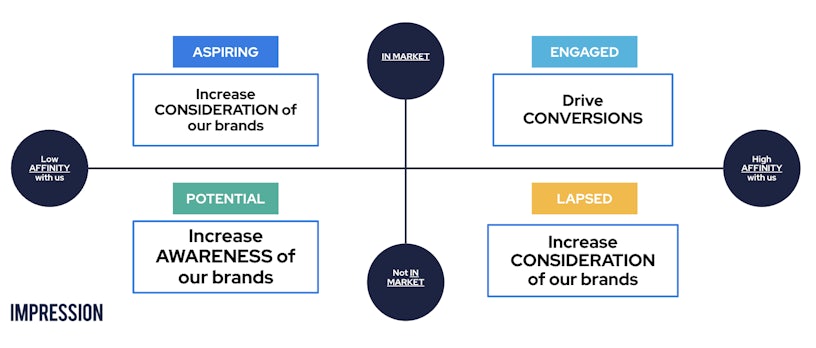As marketers, we’re facing some of the most challenging circumstances we’ve seen in recent history. The COVID-19 pandemic has resulted in a global economic downturn, causing a recession that has impacted businesses of all sizes and industries across the world. In such times, it’s vital that advertisers adapt and adjust their marketing strategies accordingly, responding to changed consumer needs and behaviour.
Our own market research at Impression identified the cost-of-living crisis to be the biggest business challenge that advertisers are set to face this year, despite 84% of businesses targeting revenue growth. To achieve ambitious targets during continued economic uncertainty, marketing strategies must evolve and adapt. This begs the question: how do we need to adjust our plans to better serve our consumer’s needs?
In order to answer this question, let’s first hone in on the biggest challenges we’re currently facing as an industry.
People are spending less
Half of UK users have cut discretionary spending, in line with energy bill support payments coming to an end, according to research from KPMG. As our research has indicated, despite consumers cutting back on their spending, the requirement for business growth is still desired. Costs are rising for the consumer and for business owners, however the latter relies on the former for success.
Understanding your customer and their needs
The phrase ‘unprecedented times’ has likely never been used more than in the years since COVID-19. Whilst we’re technically out the other side, we’re absolutely not in “BAU” times again. Consumer shopping behaviour is vastly different now than in 2019 and, whilst looking back on past data is still essential to contextualise business performance, we can’t use it as robustly to predict trends.
With soaring costs of essential items (food, fuel), luxury spending is slowing for the most affected groups. Price is a driving factor for 44% of UK customers, but sustainability is also playing a bigger part in purchase consideration than ever before. We’re in a position now where we need to consider wiping the slate relatively clean when it comes to our understanding of our customers.

Selecting the right channels
We’ve established that consumer shopping behaviour has changed in recent years, but it’s also worth considering how online behaviour has changed too. The trend established in the 2010s with the rise of YouTube has only continued, with content now digested in bitesize chunks, on newer, powerful apps like TikTok. With many businesses feeling the crunch, marketing budgets are being spent more strategically. Knowing your audience and where they’re genuinely spending their time is paramount.
Spending your budget efficiently
Establishing the right channels for your market is only half the battle. Actually getting those channels to work for you is another beast entirely. Time and time again, I find myself auditing Paid Media accounts that are set up in a way that is limiting things to such an extent that budgets (which are now more precious than ever) aren’t being spent in a way that maximises output.
Benchmarking your performance
Possibly the most challenging thing to get internal buy-in for, but the goalposts for benchmarking success are no longer a simple ‘overall year-on-year growth’ metric. Looking at the full picture, the roles of individual activity and thinking about the longer-term impact of your current marketing activities are the key to success. A short-term, quick-win view of how this month has performed vs the same last year will usually only direct you to spend less and save pennies, potentially hindering next year’s growth further.
To overcome the above challenges and to help your business adapt, here are some key considerations to approach H2 of 2023 with.
Go back to basics: Objective setting & strategic frameworks
If there’s a time for resetting and re-strategising (and you’ve not been doing this over the last year), it’s now. I’m an advocate of a robust Strategic Objective Framework. Whether you’re planning out activity across all marketing channels for your business, or you’re focussed on a single channel, everything needs a goal. For most, the goal is growth. So how do we look at this objective, and ladder it down into a framework?
Let’s attach a number to the growth you’re looking to see – your business needs a revenue increase of 15% minimum over the course of the next 12 months. Great! How can we attach micro objectives to this to give us something tangible to work towards?
- Drive greater brand awareness to generate long-term growth
- Increase efficiency of performance channels
- Diversify your activity split by testing on new channels
All of the above ladders up to the overall objective of “growth”, but provide more tangible methods of generating that growth, each of which can have its own individual metrics and milestones attached.
Understand your audience & invest accordingly
You’ve created the bare bones of a framework to generate growth. In order to meet each individual objective, we need to select the right channels for that objective specifically, as well as decide on our key audience per channel. There are a huge number of tools available to help you facilitate this, like SimilarWeb and SEMRush. Your first-party data should still be consulted throughout this process too. A key area to focus on in your own data analysis is what isn’t working now, that used to? Is YouTube no longer generating the results you saw 3 years ago? Are there individual Paid Search campaigns that have seen efficiency on a steady decline? These areas present a clear opportunity to re-strategise and think big on how to develop.

Use the right tactics for your channel
I mentioned earlier the regularity of advertisers using ill-suited tactics in their campaigns, related to their business goals. My specialism lies in Paid Media, but the principles are the same across the board:
Test, learn, repeat
This isn’t a strategy that’s breaking the mould by any means, but if you want to win, you have to be willing to lose. Adopt a robust test-and-learn framework across any and every channel you’re running. This by no means indicates that you should be reinventing the wheel every two months, but pick small, tangible areas that you can ascertain are working for you (or prove aren’t). Creative, audiences, spend – there should be no end to a testing strategy.
The creative for your customer
Speaking of creative, this is an area where we continually see advertisers slipping up. Those not willing to adjust tactics according to trends are falling by the wayside. With a client in the luxury space, we’ve recently tested User Generated Content on Meta campaigns vs their traditional (very polished and best-practice cooperative) ads, and have seen CPCs 45% lower, therefore reach and engagement significantly higher. Enlist the help of creative experts and try something new if you need to.
Right user, right channel, right time
‘Cheapest isn’t always best’ is the hard and fast rule here in my book. You need to understand what you’re willing to pay for a user depending on where they are in their journey. We’re generally seeing that for most product offerings, users are taking longer to convert. Ensuring that you’re approaching users with the right message according to what stage of the journey you believe them to be in sets you apart. ‘One size fits all’ brand-led taglines aren’t the way to go if you’re wanting to maximise your efficiency.
Allow your activity time to work
Finally, in order to establish success, we have to paint a holistic and accurate view of performance, in line with our objective framework. Simple year-on-year comparisons no longer paint a true picture of growth and, when pulling together your objective framework, inputting reasonable and long-term KPIs in line with your goals is a key requirement.
If we take the example objectives laid out earlier:
- Drive greater brand awareness to generate long-term growth
- Increase efficiency of performance channels
- Diversify your activity split by testing on new channels
If we look at year-on-year growth as a KPI for each of these, we’ll undoubtedly end up switching off the majority of activity after a one month trial. Instead, a better way of holding accountability would be through the following key results:
- Drive greater brand awareness to generate long-term growth
- Brand uplift study conducted in 6 months, post-trialled cold-audience investment on YouTube & TikTok
- Traffic increase in six months, attributed to brand awareness channels
- Increase efficiency of performance channels
- Improvements in ROAS across conversion campaigns on Paid Search, Meta & TikTok
- Diversify your activity split by testing on new channels
- Cold/warm audience test on YouTube, measuring site traffic, brand uplift response and view through rates over a six-month period
The above allows us to measure the capabilities of different marketing activities over time. Unfortunately, nothing is going to break the mould overnight, so allowing yourself to take a long-term view is a better-placed approach to set you up for success.
How does this all work in practice? Let’s look at a case study:
In 2022, Impression onboarded a client in the luxury beauty industry, and we’ve followed this exact methodology in order to drive results for them. We:
- Analysed third-party tools to build an understanding of their customers and prospects
- Bucketed audiences and created groupings, based on intent to purchase
- Assigned priority channels by audience, in which we established TikTok as an untapped method of engaging with potential and aspiring customers
- Implemented full funnel Paid Media strategies, across TikTok, Meta, Google & Bing Ads, with bespoke creative for each platform

The important thing to emphasise with this strategy is that the results were not immediate, and took 3+ months to deliver the desired return. During that time, we conducted ongoing optimisation to ensure campaigns had the opportunity to perform their best.
After 3 months, our full-funnel investment had driven a 41% uplift in revenue through engaged users, increased branded search demand by 40% and drove a 45% uplift in Share of Search (acquiring share from a key competitor).
This example is a simplified way of demonstrating the value of objective frameworks, understanding your customer and listening to multiple data sources. The reality of this was months of hard work and research, testing and learning and a lot of patience… but it really does pay off!
Getting your strategy right takes time – it certainly isn’t easy. Adapting to the changing world around us is vital in order to keep up and succeed. If there are three things you take away from reading this, it should be:
- Re-learn who your audience is. Their lives have changed, so you can’t keep talking to them the same way
- Reassess what good looks like to you. We’ve gone through a pandemic and are in the midst of a consumer confidence crisis – the ballpark has changed
- Give yourself time. Success has never come overnight, it’s certainly not going to start happening now
For more tips, tactics and strategies for your PPC marketing activity, check out our blog. If you have any questions about the topics raised in this blog, get in touch!



